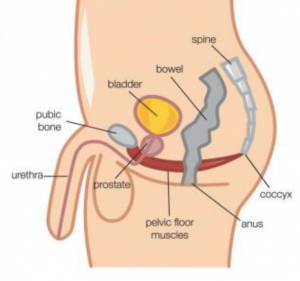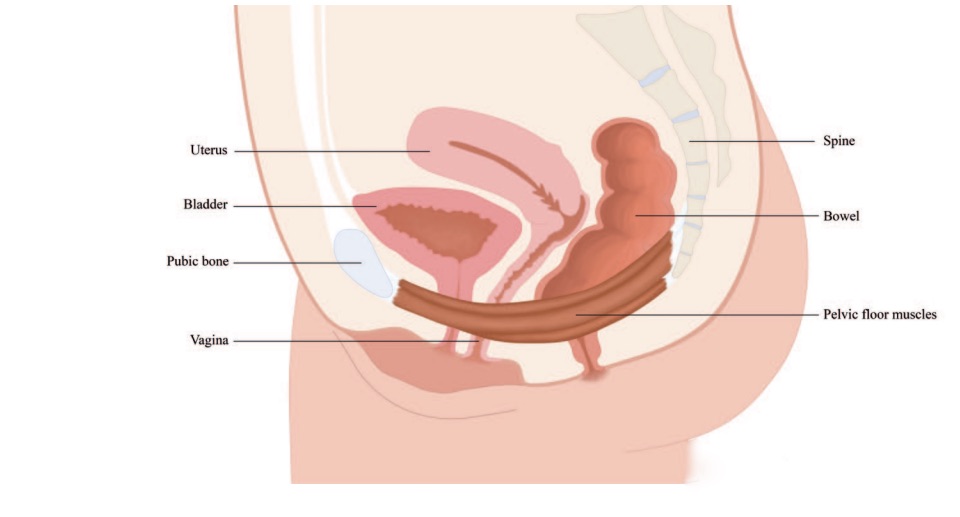Everyone should do pelvic floor exercises, and yes, men too!
Having a strong core is not all about your abs. Your pelvic floor (“PF”) muscles work as part of your ‘core’ to regulate the internal pressure in the abdominal cylinder along with the abdominal, back and breathing muscles. The PF muscles act like a hammock to support the pelvic organs. Most people ignore them until there is a problem, but we would all really benefit from exercising them daily. Strong PF muscles prevent incontinence and prolapses, and if it’s not an incentive enough, they also improve your sex life and quality of your orgasm! I’ll leave it there, but if you aren’t convinced, Google it and see the further resources at the bottom of this article!
How can PF muscles become weak in men?

PF muscles can become weak in men due to heavy lifting, being overweight, long-term constipation, a persistant cough or prostate surgery.
Why are PF muscles important in pregnancy?
During pregnancy, the PF has the additional job of supporting the weight of a growing baby and your PF is super important in childbirth. When the time comes to PUSH, it is the pelvic floor muscles that do the work – the stronger and healthier your PF muscles, the easier (hopefully!!) deliver will be.
Why do the PF muscles need to be strengthened post-pregnancy?
During labour, the PF muscles stretch to allow the baby to pass through. Afterwards, it is very common to experience postpartum pain and incontinence due to the weakened PF muscles. Strengthening the muscles with PF exercises will help women recover a lot quicker. Even if you have had a c-section, you should still strengthen your PF muscles post pregnancy due to the amount of weight and pressure your baby has placed on them during your pregnancy.
Why do we need to strengthen the PF muscles during and after the menopause?
Oestrogen is one of the most important hormones in the female body and it is important for our PF too! During the menopause, when oestrogen levels take a nose dive, the PF can weaken and cause problems, such as incontinence.
What PF exercises should we do?
The pelvic floor muscles include both fast-twitch and slow twitch muscle fibres. Fast-twitch muscles are those that react rapidly, whereas slow-twitch muscles are endurance muscles, they have a constant tone and work all the time. We need to exercise both types of muscle fibres.
How do you activate your PF muscles?
Imagine that you are trying to stop yourself from passing wind and at the same time trying to stop passing urine. Slowly squeeze and lift up; you should feel the squeeze and lift up. For men, you may feel the base of your penis slightly move upwards towards your abdomen. For women, it can be helpful to imagine squeezing round an object like a tampon or keeping a kegel weight lifted up inside. As you engage your PF, you may feel a tightening in of your lower abdomen and this is normal. However, you want to concentrate on the PF activation and not pulling in your tummy muscles, and avoid clenching your buttocks, tensing your body or holding your breath.
PF exercises to practise
Long squeezes – Engage your PF muscles and hold them tightly for as long as you can. Time yourself, how long can you hold your PF up for? Can you hold for 10 seconds? Relax your pelvic floor and then practise contracting your PF again and holding, then release. Practise this exercise up to 10 times, so 10 slow holds per day.
Short squeezes – Quickly engage your PF muscles and then immediately let them go. How many quick squeezes can you do before the muscles become tired? Let the muscles fully relax after each squeeze. See if you can practise doing 10 quick lifts and then repeat these lifts, 10 times! So yes, 100 quick lifts a day. You can break it up and practise 3 times a day for example.
Tips
- If you find you can only hold your PF lift for a short time, start with little and often exercises, until you build up more strength.
- Set yourself a daily reminder. For example, I have a reminder set on my phone 3 times a day.
- The more you get used to doing the exercises, you can actually do them anywhere and anytime. For example, if you have a commute, do them on your commute to and from work, whilst feeding your baby, whilst waiting in a queue, whilst having …, walking or running.
Further resources –
https://www.ouh.nhs.uk/patient-guide/leaflets/files/11124Ppelvic.pdf
If you have any questions, please do not hesitate to get in contact – info@elizabethnadine.com

